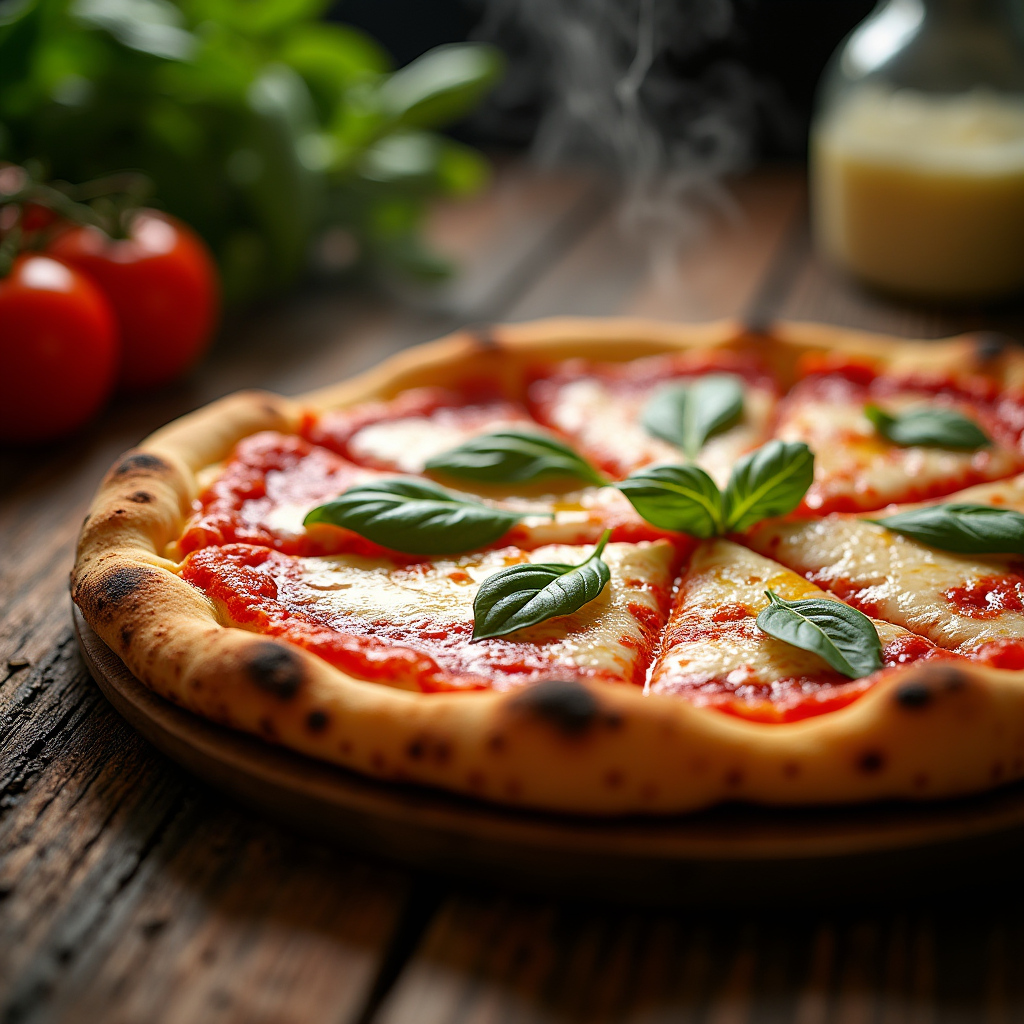Introduction: A Slice of Italy in Every Bite
Imagine pulling a piping hot Margherita pizza straight from the oven with a golden, crispy crust with just the right amount of char, rich tomato sauce bursting with natural sweetness, creamy mozzarella melting into every bite, and fragrant basil adding a touch of freshness.
This isn’t just any pizza; it’s a piece of history. Originating in Naples, Italy, this simple yet flavorful creation has become a worldwide favorite. Whether you’re a home cook or just a pizza enthusiast, learning to make an authentic Margherita pizza will transform your appreciation for traditional Italian cuisine.
In this guide, you’ll discover the rich history, essential ingredients, step-by-step preparation, and expert tips for perfecting this timeless classic. Let’s dive in!
Table of Contents
What is Margherita Pizza?
Margherita Pizza is the epitome of simplicity and elegance in Italian cuisine. Unlike heavily loaded American-style pizzas, this dish highlights just three core ingredients:
- Tomato sauce – Traditionally made from San Marzano tomatoes, known for their balanced sweetness and acidity.
- Mozzarella cheese – Preferably fresh buffalo mozzarella for an authentic taste and creamy texture.
- Basil leaves – Added after baking to maintain their fresh, aromatic quality.
Each ingredient plays a crucial role in creating a perfect harmony of flavors, making Margherita pizza a timeless classic.

The History of Margherita Pizza
Who Invented Margherita Pizza?
The origins of Margherita pizza trace back to 1889 when Raffaele Esposito, a renowned pizzaiolo in Naples, was commissioned to create a special pizza for Queen Margherita of Savoy. Inspired by the Italian flag, he crafted a pizza using red tomatoes, white mozzarella, and green basil.
The Queen loved it, and thus, the Margherita pizza was born as a dish that continues to captivate taste buds across generations.
How Margherita Pizza Became a Global Sensation
Over the years, Italian immigrants brought their beloved recipes to new lands, spreading the art of pizza-making across the globe. Today, you’ll find Margherita pizza in pizzerias worldwide, from traditional Neapolitan spots to modern gourmet restaurants.
Despite variations in preparation, the essence of this dish remains unchanged: quality ingredients, simple preparation, and a respect for tradition.
Authentic Margherita Pizza Recipe (Neapolitan Style)
Ingredients You’ll Need
| Ingredient | Quantity | Notes |
|---|---|---|
| Tipo 00 Flour | 3 ½ cups | Fine Italian flour for a light, airy crust |
| Water | 1 ¼ cups | Room temperature |
| Salt | 1 ½ tsp | It prevents sticking when baking |
| Active Dry Yeast | 1 tsp | Helps with fermentation |
| San Marzano Tomatoes | 1 can (14 oz) | Best for an authentic, balanced sauce |
| Fresh Mozzarella | 6 oz | Buffalo mozzarella preferred |
| Fresh Basil Leaves | 6-8 leaves | Whole, not chopped |
| Extra Virgin Olive Oil | 2 tbsp | Drizzle for enhanced flavor |
| All-Purpose Flour | As needed | For dusting |
| Semolina Flour | As needed | Prevents sticking when baking |
Step-by-Step Instructions

1. Prepare the Dough
- In a bowl, combine warm water, yeast, and a pinch of sugar. Let it sit for 5-10 minutes until foamy.
- Add flour and salt, mixing until a shaggy dough forms.
- Knead for 8-10 minutes until smooth and elastic.
- Cover and let rise at room temperature for 8-12 hours (for the best flavor, refrigerate overnight).
2. Make the Sauce
- Blend San Marzano tomatoes with a pinch of salt until smooth.
- No need to cook—this keeps the natural sweetness intact.
3. Assemble the Pizza
- Preheat your oven to 500°F (260°C) or higher. Use a pizza stone if available.
- Stretch the dough into a 10-12-inch circle on a floured surface.
- Spread a thin layer of tomato sauce using the back of a spoon.
- Tear fresh mozzarella and distribute evenly.
- Drizzle with olive oil.
4. Bake to Perfection
- Wood-fired oven: Bake at 900°F (480°C) for 60-90 seconds.
- Home oven: Bake at 500°F for 7-10 minutes or until the crust is golden and cheese is bubbly.
- Add fresh basil after baking to preserve its flavor.

Tips for the Best Homemade Margherita Pizza
- Use high-quality ingredients – The simpler the recipe, the more important the quality.
- Preheat your oven properly – A hot oven ensures a crispy, airy crust.
- Don’t overload toppings – Too much cheese or sauce can lead to sogginess.
- Invest in a pizza stone or steel – This helps mimic a wood-fired oven’s effect.
- Let your dough rest – A slow fermentation enhances flavor.
Margherita Pizza Variations You Must Try
Classic Neapolitan vs. Modern Interpretations
- Neapolitan Style – Traditional, soft, and slightly charred crust.
- Modern Style – Often includes garlic, burrata cheese, or truffle oil for a gourmet touch.
Vegan Margherita Pizza
- Swap regular mozzarella for cashew-based cheese or plant-based alternatives.
- Use olive oil-infused basil pesto for an extra flavor boost.
Margherita Pizza vs. Other Pizza Styles
| Feature | Margherita Pizza | Pepperoni Pizza | White Pizza |
|---|---|---|---|
| Sauce | Tomato-based | Tomato-based | Olive oil-based |
| Cheese | Fresh mozzarella | Shredded mozzarella | Ricotta or mixed cheeses |
| Toppings | Basil, olive oil | Pepperoni slices | Garlic, spinach, ricotta |
| Cooking Style | Wood-fired/high temp | Standard oven | Various methods |
FAQs About Margherita Pizza
What makes Margherita pizza different from other pizzas?
Unlike loaded pizzas, Margherita Pizza focuses on minimal, high-quality ingredients, allowing each flavor to shine.
Can I make Margherita pizza without a pizza stone?
Yes! Use a preheated baking sheet or cast-iron skillet for a similar effect.
What is the best mozzarella for Margherita pizza?
Buffalo mozzarella is ideal for an authentic taste and creamy texture.
Why is Margherita Pizza so popular?
Its balance of flavors, simplicity, and historical significance make it a timeless favorite.
Conclusion: A Timeless Classic Worth Savoring
Margherita pizza isn’t just a meal it’s an experience. Every bite carries a piece of Italy’s rich culinary tradition, proving that sometimes, the simplest dishes are the most extraordinary.
Now, it’s your turn! Try this recipe, experiment with your variations, and share your results. Let us know what’s your secret to the perfect Margherita Pizza.

